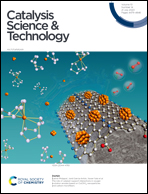A green approach for the preparation of a surfactant embedded sulfonated carbon catalyst towards glycerol acetalization reactions†
Abstract
The green synthesis of heterogeneous catalysts often requires a solid-state reaction pathway. In this work, a cationic surfactant (CTAB) embedded sulfonated carbon catalyst was prepared via a sustainable route with the aim of having controlled surface hydrophobicity and acidity for glycerol acetalization reactions. The main objective of this study was to tune the hydrophobicity and acidic site density, either via adding a cationic surfactant or changing the carbon to sulphur ratio. The as-synthesized catalyst was characterized via XRD, N2 adsorption/desorption, SAXS, FESEM, FTIR, pyridine-IR, high-temperature DR-FTIR, TGA, 13C-NMR, Raman, and XPS techniques. The incorporation of a cationic surfactant (CTAB) reduces the surface area but increases the acidic site density to a greater extent. The bonding between the surfactant (CTAB) and surface hydroxyl groups was elucidated via XPS analysis. DR-FTIR studies implied that the –SO3H groups are strongly bonded to the carbon network, while the lower amount of water mass loss seen from TGA studies showed the substantial improvement in surface hydrophobicity after modification with the surfactant. Moreover, the combination of acidic site density and hydrophobicity played a key role in attaining around 90% glycerol conversion and 98% solketal selectivity under ambient conditions. Notably, characterization of the used catalyst revealed that the loss of activity is mainly related to a drop in hydrophobicity, which occurs due to the loss of surfactant during washing with methanol.



 Please wait while we load your content...
Please wait while we load your content...